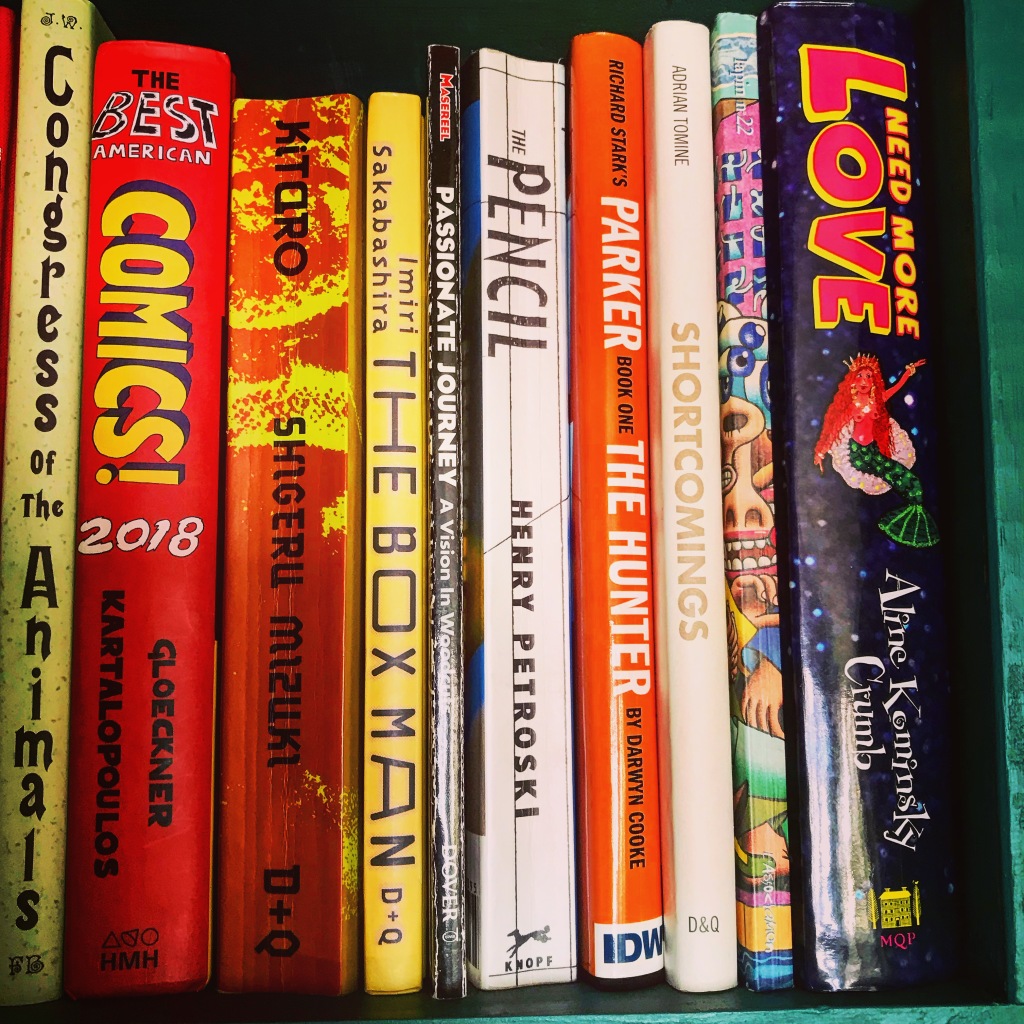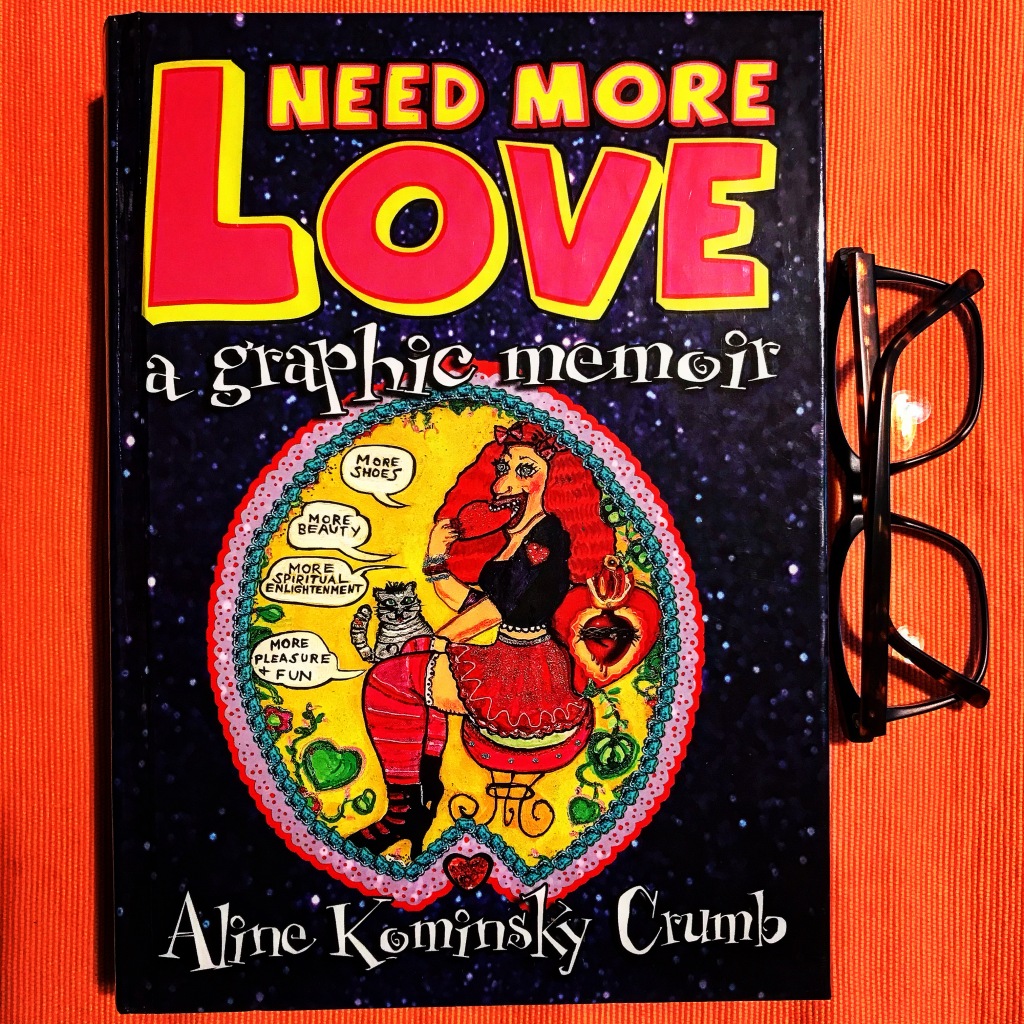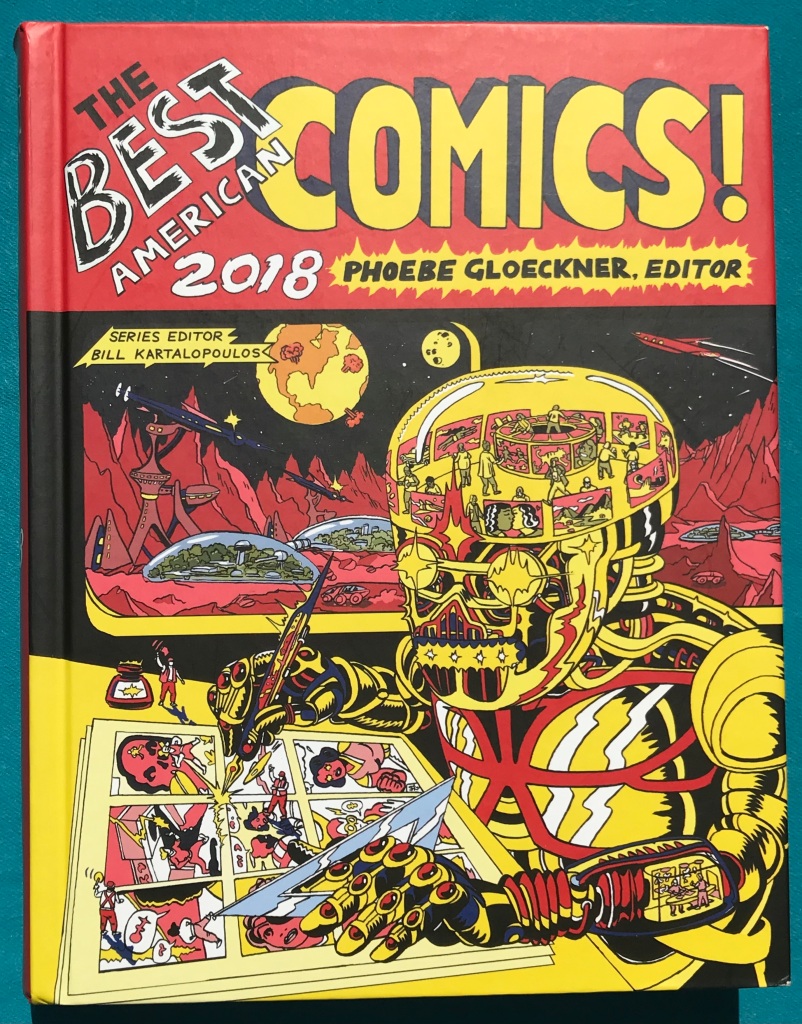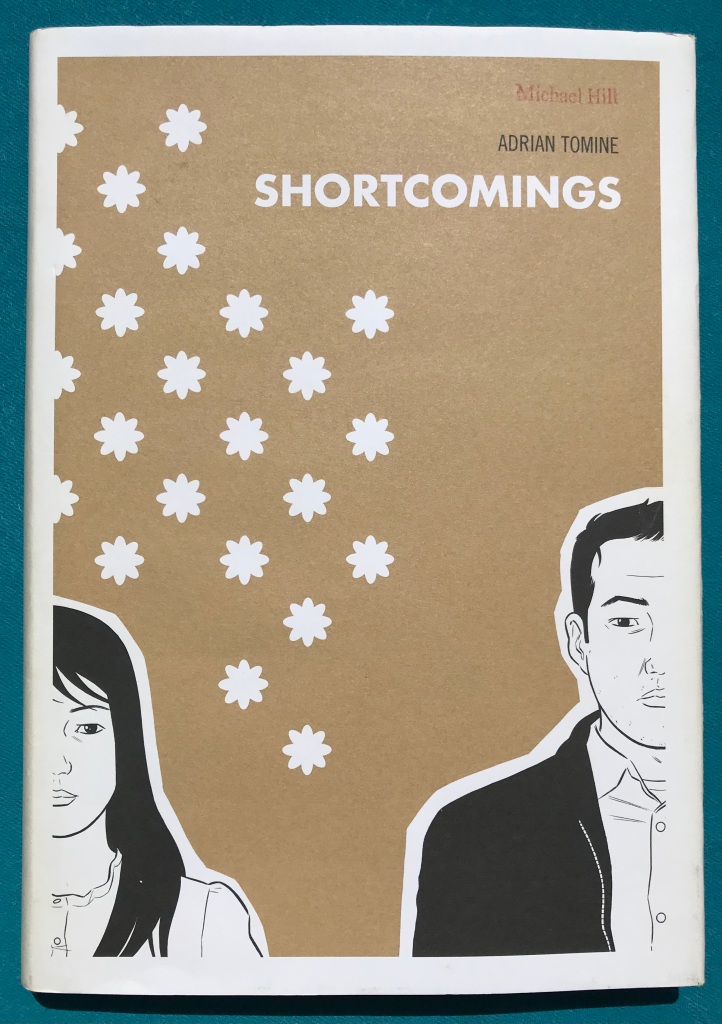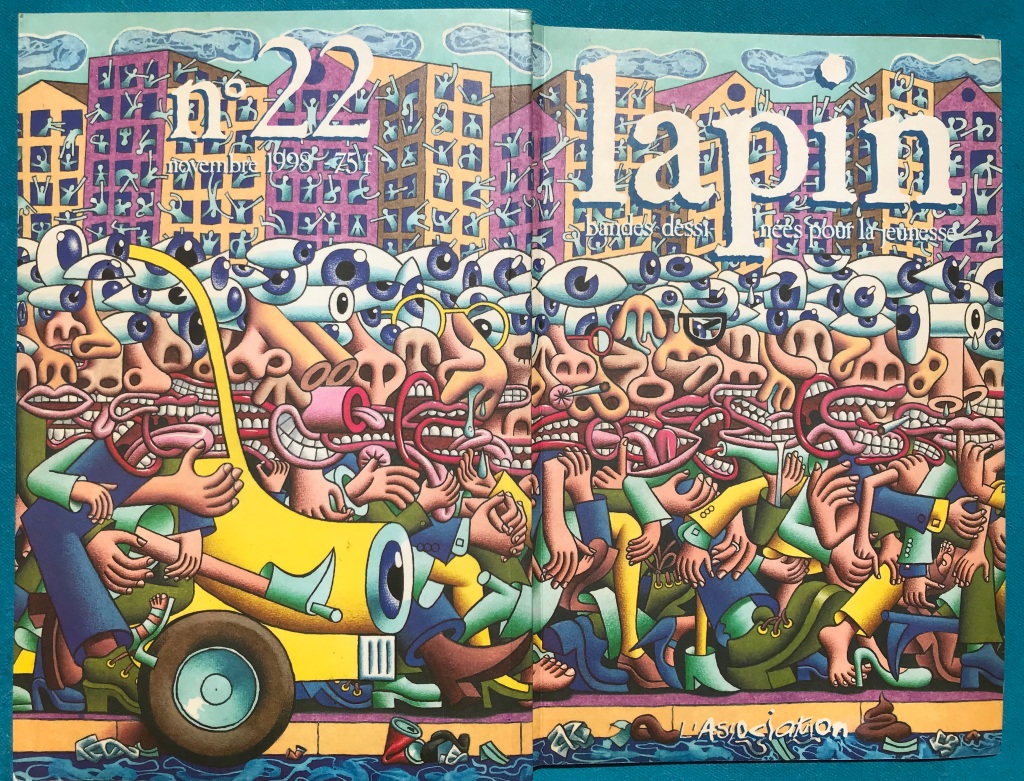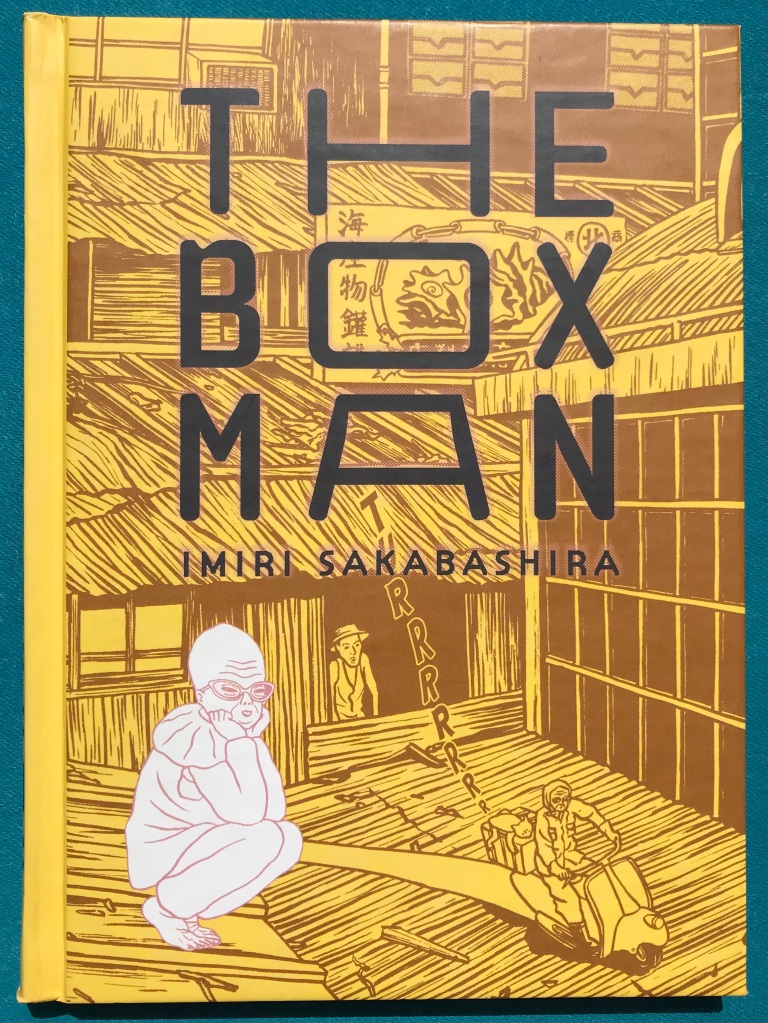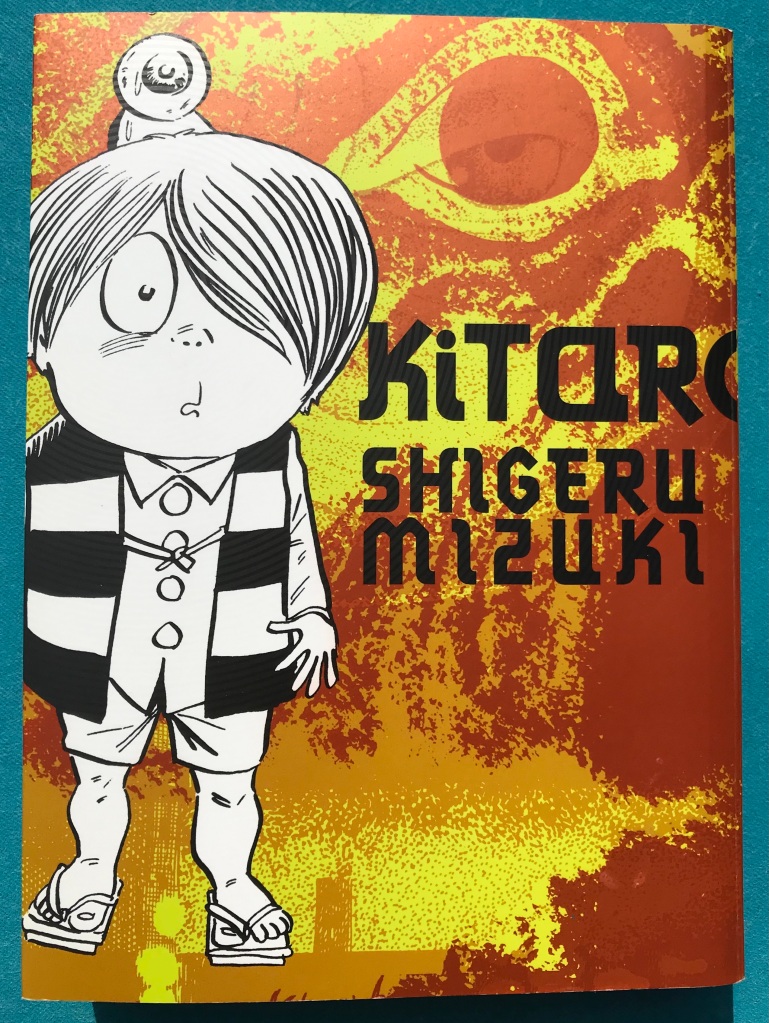Welcome to another visit to my modest library collection of comics and books about comics related to my research, study and enjoyment of the comics medium. In this series of posts I focus on a small section of books, comics or graphic novels on my shelves, select one or two or three or more, sometimes even the entire grouping, from that section and take a closer look at some of them. This time I shall be pushing that total to ten as every book in the photo will get a mention! It’s a bumper post and, as I stated in previous posts on this topic, the books are not shelved following normal library rules i.e. detailed categorisation…they are stacked instead more by size…what a surprise!…sorted by size rather than specific subject…however, they essentially all have something to do with the rubrics of comics, being either comics, collections of comics or histories, studies and critiques of comics.
Somewhat similar in size, at least in the vertical dimension, this grouping is a real mixed bag in terms of content…from Aline Kominsky Crumb to Jim Woodring with side visits to Frans Masereel, Shigeru Mizuki and L’ Association, not to mention the history and design of the humble pencil. That last item, on pencils, is a real find. So the above photo shows these ten volumes in this section of my shelves and what follows is a brief profile of each one of them. (Photo-©2023 Dr. Michael Hill) I am beginning this blog post with NEED MORE LOVE: a graphic memoir, the stunning book by Aline Kominsky Crumb published by MQ Publications in 2007. It’s a big volume with close to 400 pages in length. These are spread over five chapters including Love-Marriage-Motherhood, Mid-Life Crisis, and The Kominsky Code . It comes with illustrations, which a combination of photos(including several family photos of other famous Crumbs), text, cartoons and sequences from her comics as well as her contributions to other comics such as WIMMEN’S COMIX . (Photo-©2023 Dr. Michael Hill) THE BEST AMERICAN COMICS was quite an impressive publication series that ran from 2006 to 2019, this one from the penultimate year with Phoebe Gloeckner as editor and Bill Kartalopoulos as series editor, and with cover art on this edition by comics artist Lale Westvind. There are over 30 contributors in this volume including Gabrielle Bell, Guy Delisle, Casanova Frankenstein, Sarah Glidden, Simon Hanselmann, Jaimie Hernandez, Gary Panter, Ariel Schrag, Matthew Thurber and Lale Westvind, each contributing an extract or short piece of their work. Good to see it added to the “Best Of” series and such a shame that series didn’t last. (Photo-©2023 Dr. Michael Hill)Staying in the United States there is this 2011 graphic novel in a quality pressing from Fantagraphics Books, titled Congress of the Animals that has been written, illustrated and designed by Jim Woodring “in control of everything,” as he does. It features the adventures of his feline character Frank. The book is beautifully drawn and written by Woodring and appropriately published. (Photo-©2023 Dr. Michael Hill). Next is a hard covered book of a hard-boiled private detective in a hard hitting storied graphic novel of Darwin Cooke’s adaption of Richard Starke’s novel Parker the Hunter classily presented by IDW Publishing in 2009. Set in New York in the 1960s the borderless panels give the artwork a rough, energetic style and a fluid passage through the pages. The seemingly continuous movement from panel to panel is sometimes employed to provide a quasi-cinematic effect in the telling of this crime fiction tale. Lots of energy and violence are conveyed in the visuals. (Photo-©2023 Dr. Michael Hill) Still in America we have Adrian Tomine’s graphic novel SHORTCOMINGS published in a hardcover format by Drawn and Quarterly in 2007. This is a disciplined study, carefully drawn in monochromatic form, predominantly and appropriately in close-up, with an emphasis on facial expression and dialogue to convey the conversation, conflict and emotional reaction arising from problematic relationships. The worried, hurt and lost state is conveyed from the get-go in the illustration on the cover of the book by the author. (Photo-©2023 Dr. Michael Hill) Crossing over to Europe and the land of the bandes dessinees we have LAPIN No. 22: bandes dessinees pour la jeunesse , a stunning collection of short comics from L’ Association in Paris that includes work, whether short pieces or extracts, from such comics artists as Lewis Trondheim, Jean-Christophe Menu, Guy Delisle, Joann Sfar, Edmond Baudoin, Jim Woodring, Paquito Bolino, Caroline Sury, Jochen Gerner, Fabio, Matthieu Blanchin and Placid. This selection of contributors brings to the volume a wonderful range of graphic styles and storytelling. The massively crammed, chaotic cover illustration, above, is by Killoffer. (Photo-©2023 Dr. Michael Hill)
PASSIONATE JOURNEY: A Vision In Woodcuts created by the Flemish artist Frans Masereel and published by Dover Publications in 2007. It contains more than 160 intensely monochromatic reproductions of his wordlessly accompanied woodcut prints that make up this graphic novel. It was originally published in 1919 well before the concept of the “graphic novel” came into popular usage. Wordless and woodcut are the two key words. The actual prints are quite small, measuring around 3 by 2 inches but these have been slightly enlarged for this publication. I quite like this use of printmaking for the generation of images for comics. It’s a very graphical read. (Photo-©2023 Dr. Michael Hill)
Crossing to Japan for THE BOX MAN by the mangaka, animator and musician Imiri Sakabashira, translated into English by Taro Nettleton and published by Drawn & Quarterly in 2009. I found this to be a really fast page turner and a bizarre ‘trip’ of a read. It’s a journey type manga and it really flows along through time and space and with its series of striking images it flows along like a graphic trip. (Photo-©2023 Dr. Michael Hill) Also from Japan, a 400 page manga titled KITARO by Shigeru Mizuki, translated into English by Jocelyne Allen and published by Drawn & Quarterly in 2013. Kitaro is a one-eyed boy accompanied by an eyeball headed embodiment of his dead father, called Medama Oyaji, who lives in his other, empty, eye socket. There is a call, a chant, “GE GE GE NO KITARO” that occasionally occurs in the yokai/spirit world throughout this manga. Mizuki’s style is both engaging and entertaining and impressive in terms of his range of character design and storytelling skills. (Photo-©2023 Dr. Michael Hill) …and finishing where I assume many comics begin, with the archetypal drawing device, the humble pencil, from which most comics take their initial shape. Written and researched by Henry Petroski: THE PENCIL: A History Of Design And Circumstance is not a how-to book about drawing but an essential historical background knowledge of the engineering role played by the development of the humble pencil and its design and manufacture in a range of countries. It’s a rewarding read and re-read. (Photo-©2023 Dr. Michael Hill)BLOTTING PAPER: The Recollected Graphical Impressions of Doctor Comics plus my scholarly research and study of the comics medium.
